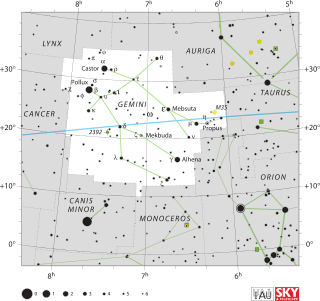Delta Geminorum

| |
| Observation data Epoch J2000 Equinox J2000 | |
|---|---|
| Constellation | Gemini |
| Right ascension | 07h 20m 07.37978s[1] |
| Declination | +21° 58′ 56.3377″[1] |
| Apparent magnitude (V) | +3.53[2] |
| Characteristics | |
| Spectral type | F0 IV[3] |
| U−B color index | +0.04[2] |
| B−V color index | +0.34[2] |
| Astrometry | |
| Radial velocity (Rv) | +4.1[4] km/s |
| Proper motion (μ) | RA: –15.13[1] mas/yr Dec.: –9.79[1] mas/yr |
| Parallax (π) | 53.94 ± 0.66[1] mas |
| Distance | 60.5 ± 0.7 ly (18.5 ± 0.2 pc) |
| Details | |
| Mass | 1.57[5] M☉ |
| Temperature | 6,900[6] K |
| Metallicity [Fe/H] | –0.26[6] dex |
| Rotational velocity (v sin i) | 129.7[7] km/s |
| Age | 1.6[6] Gyr |
| Other designations | |
Delta Geminorum (δ Gem, δ Geminorum) is a star in the constellation Gemini. It has the traditional name Wasat, which comes from the Arabic word for "middle".[8][9]
It has an apparent visual magnitude of +3.53,[2] allowing it to be seen with the naked eye. Wasat is only two-tenths of a degree south of the ecliptic, and therefore is occasionally occulted by the Moon and, more rarely, by a planet. The last occultation by a planet was by Saturn on June 30, 1857, and the next will be by Venus on August 12, 2420. In 1930, the dwarf planet Pluto was discovered about 0.5° to the east of this star by American astronomer Clyde Tombaugh.[10]

In Chinese, 天樽 (Tiān Zūn), meaning Celestial Wine Cup, refers to an asterism consisting of δ Geminorum, 57 Geminorum and ω Geminorum.[12] Consequently, δ Geminorum itself is known as 天樽二 (Tiān Zūn èr, English: the Second Star of Celestial Wine Cup.).[13] From this Chinese name, the name Ta Tsun has appeared.[14]
Properties
Delta Geminorum is a subgiant star with the stellar classification F0 IV.[3] It is about 60.5 light-years (18.5 parsecs) distant.[1] This star has 1.57 times the mass of the Sun[5] and is rotating rapidly with a projected rotational velocity of 129.7 km s−1.[7] The estimated age is 1.6 billion years.[6]
Wasat is a member of a triple star system. The inner components form a spectroscopic binary with a period of 6.1 years (2,238.7 days) and an orbital eccentricity of 0.3530. A cooler class K companion is not apparent to the naked eye but clearly visible in a small telescope. It orbits the inner pair with a period of 1,200 years and an eccentricity of 0.11.[15][16] Although according to [4] its radial velocity is away from the Sun, it is actually approaching the Solar System. In about 1.1 million years, it will make its closest approach at a separation of roughly 6.7 ly (2.1 pc).[17]
References
- 1 2 3 4 5 6 van Leeuwen, F. (November 2007), "Validation of the new Hipparcos reduction", Astronomy and Astrophysics 474 (2): 653–664, arXiv:0708.1752, Bibcode:2007A&A...474..653V, doi:10.1051/0004-6361:20078357
- 1 2 3 4 Johnson, H. L.; et al. (1966), "UBVRIJKL photometry of the bright stars", Communications of the Lunar and Planetary Laboratory 4 (99), Bibcode:1966CoLPL...4...99J
- 1 2 3 "Delta Geminorum (Wasat)", SIMBAD (Centre de Données astronomiques de Strasbourg), retrieved 2011-06-03
- 1 2 Evans, D. S. (June 20–24, 1966), Batten, Alan Henry; Heard, John Frederick, eds., The Revision of the General Catalogue of Radial Velocities, University of Toronto: International Astronomical Union, retrieved 2009-09-10
- 1 2 Shaya, Ed J.; Olling, Rob P. (January 2011), "Very Wide Binaries and Other Comoving Stellar Companions: A Bayesian Analysis of the Hipparcos Catalogue", The Astrophysical Journal Supplement 192 (1): 2, arXiv:1007.0425, Bibcode:2011ApJS..192....2S, doi:10.1088/0067-0049/192/1/2
- 1 2 3 4 Nordström, B.; et al. (May 2004), "The Geneva-Copenhagen survey of the Solar neighbourhood. Ages, metallicities, and kinematic properties of ˜14 000 F and G dwarfs", Astronomy and Astrophysics 418: 989–1019, arXiv:astro-ph/0405198, Bibcode:2004A&A...418..989N, doi:10.1051/0004-6361:20035959
- 1 2 Schröder, C.; Reiners, A.; Schmitt, J. H. M. M. (January 2009), "Ca II HK emission in rapidly rotating stars. Evidence for an onset of the solar-type dynamo", Astronomy and Astrophysics 493 (3): 1099–1107, Bibcode:2009A&A...493.1099S, doi:10.1051/0004-6361:200810377
- ↑ Kaler, Jim (n.d.). "WASAT (Delta Geminorum)". Stars (University of Illinois sponsored website). Retrieved July 29, 2014.
The name is a mess, "Wasat" meaning "middle" in Arabic, but the middle of WHAT is not clear, whether the middle of Gemini, of the sky, or of the neighboring constellation Orion (which the Arabs referred to as the "Central One"), the star name improperly applied to our Delta.
- ↑ Allen, Richard (1889). "The history of the star: Wasat, from p.234 of Star Names, Richard Hinckley Allen, 1889.". Constellations of Words website. Retrieved July 29, 2014.
Wasat and Wesat are from Al Wasat, the Middle, i.e. of the constellation; but some have referred this to the position of the star very near to the ecliptic, the central circle.
- ↑ O'Meara, Stephen James (2002), The Caldwell objects, Deep-sky companions, Cambridge University Press, p. 156, ISBN 0-521-82796-5
- ↑ King, Bob (12 December 2013). "To Delta Geminorum by way of Jupiter and Pluto". Astro Bob. Areavoices.com. Retrieved 13 December 2013.
- ↑ (Chinese) 中國星座神話, written by 陳久金. Published by 台灣書房出版有限公司, 2005, ISBN 978-986-7332-25-7.
- ↑ (Chinese) 香港太空館 - 研究資源 - 亮星中英對照表, Hong Kong Space Museum. Accessed on line November 23, 2010.
- ↑ Richard Hinckley Allen: Star Names — Their Lore and Meaning: Gemini
- ↑ Abt, Helmut A. (August 2005), "Observed Orbital Eccentricities", The Astrophysical Journal 629 (1): 507–511, Bibcode:2005ApJ...629..507A, doi:10.1086/431207
- ↑ Kaler, James B., "WASAT (Delta Geminorum)", Stars (University of Illinois), retrieved 2012-01-30
- ↑ García-Sánchez, J.; et al. (November 2001), "Stellar encounters with the solar system", Astronomy and Astrophysics 379: 634–659, Bibcode:2001A&A...379..634G, doi:10.1051/0004-6361:20011330
External links
- Delta Geminorum on WikiSky: DSS2, SDSS, GALEX, IRAS, Hydrogen α, X-Ray, Astrophoto, Sky Map, Articles and images
| ||||||||||||||||||||||||||||||||||||||||||||||||||||||||||||||||
| ||||||||||||||||||||||||||||||||||